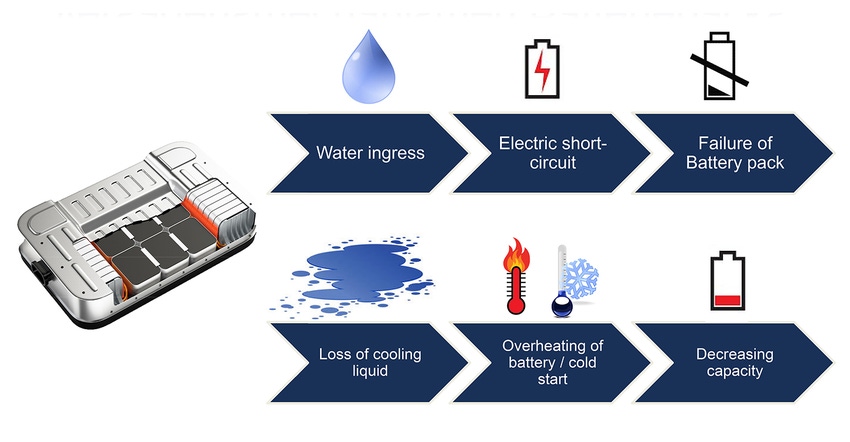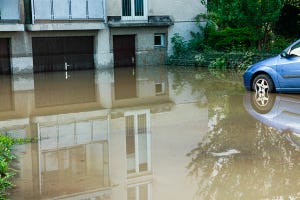Gas-leak testing equipment developer Inficon’s automotive expert talks about leak testing methods in the industry, the limiting factors for leak testing lithium-ion batteries and the future of leak testing automotive standards.

Electric vehicle (EV) manufacturers are aware of the dangers that lithium-ion battery pack failures (e.g., water ingress, loss of cooling liquid, electric shock circuit) might trigger thermal runaway ̶ primary risks related to lithium-ion batteries ̶ and they can also extremely affect the performance of a battery pack. Leak testing companies and EV manufacturers are investing more time and money into finding more reliable and cost-effective leak testing methods for lithium-ion batteries.
Inficon develops analysis, measurement and control products used for gas leak detection in automotive manufacturing. Thomas Parker, Inficon’s automotive leak testing sales manager, spoke to Battery Technology regarding what battery and automotive manufactures need to know about leak testing.
Testing more than battery cells
Inficon provides multiple leak testing solutions for many automotive parts, including the battery cells and packs for EVs. “For battery cells, we make a helium leak pre-test and then we also do an electrolyte test because that is the component that most costumers are worried about. Customers worry about battery formation [which is a chemical process where electrolyte is added to the cell],” Parker said.
When talking about leak testing for battery packs, Parker highlighted the fact that battery packs contain multiple electrical connections and that they also include cooling channels that are operated with glycol-water solution or else with refrigerant liquid bypassed from the AC system of the vehicle.
“Testing the battery pack for liquid water ingress could also be done by using helium tracer gas method but typically there would also be a robotic arm for employing a sniffing leak testing method. When a leak is found by the robotic arm, then a human in a rework station can locate and repair the leak,” he continued.
Adapting to EV manufacturing speed
Parker’s group does leak testing in manufacturing at the tier supply level. “The tier suppliers will send the various battery components to battery assembly” and those individual components leak-tested individually, he said. “But we also do leak testing of the assembled battery pack.” According to Parker, Inficon leak testing can be seamlessly integrated into the manufacturing process.
But the growing demand for EVs is not only boosting manufacturers’ EV production plans but also changing the automotive manufacturing model. Parker mentioned how Inficon found itself working with people that used to work for decades in the powertrain leak-testing field but who are now responsible for EV battery packs.
Inficon’s dealership department is still working on where and how to meet OEM specifications when doing testing and repairing battery packs.
“Everything is happening so fast in EV manufacturing. OEMs are still not clear on how to treat aftermarket repairs on batteries,” he noted. “Should they completely remove the battery and send it to a rebuild facility? Or, if they do leak testing and repairs at the dealership, how can they return the battery to the OEM’s specifications?”
Limiting factors for leak testing EV batteries
According to Parker, the need of automakers to get parts out of a manufacturing line as fast as possible is limiting the effectiveness of leak testing for EV batteries. “Costumers have been trying to use economical air leak testing on some key components and they are finding out that air testing is not good enough to fight leak rating to keep water out. Nobody wants to over-test because mainly of profitability issues.” Parker said.
He explained how a number of different leak test methods currently used for other types of components do not work as well in lithium-ion battery manufacturing. For example, leak test methods that are accurate for testing airbags in a car are not proving to be as efficient or accurate for EV batteries.
“Pressure decay testing works well if there is a rigid part component because it is not going to expand,” he said “A rigid part could be pressurized up to 200 psi and then after a certain amount time you watch for changes of pressure. But battery packs are very thin and expandable, and they can change volume. To make matters worse, such battery packs can only be pressurized up to 1–2 psi to avoid damage. In other words, if you put a pressure gauge on a battery pack and let it sit for hours, you might be able to see a pressure change. Essentially, the time it takes to effectively do a leak test is longer than the manufacturing process can afford,” Parker said.
Leak testing standards for lithium-ion batteries
In the US there are not yet standards in place for leak testing lithium-ion batteries but there are committees in place working on them. Neither test method has provided the reliably consistent results needed to establish industry-wide standards for battery cell leak detection, he explained.
“The developing of standards takes time. For example, in China the EV market was very quick to adopt standards and early on the Chinese EV market had a more structured outlook on how to leak test and create standards, whereas years later, here in the US we are still working on best practices,” Parker said.
In 2020, Inficon authored an SAE International paper on advanced lithium-ion leak detection that could lead to the establishment of the industry's first reliable quality-control standards for battery cells. The paper is entitled, “Methods for leak testing lithium-Ion batteries to assure quality with proposed rejection limit standards.”
So far, there are no reliable tests on which to base leak-detection standards for a full range of soft-pouch, cylindrical or prismatic battery cells in use throughout the industry. In the SAE paper, Inficon presented a method to reliably and quantitatively detect leakage from battery cells through the detection of escaping liquid electrolyte vapors, typically dimethyl carbonate (DMC). The proposed method does not require the introduction of an additional test gas into battery cells. The test system, which is non-destructive in nature, is applicable to non-rigid pouch cells and rigid prismatic or cylindrical cells.
About the Author(s)
You May Also Like





